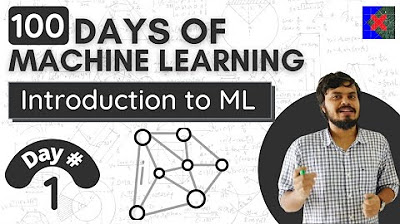Aula 4 - Modelos de machine learning; pré-processamento de variáveis preditoras
Summary
TLDRThis video delves into the core concepts of machine learning algorithms, with a specific focus on their applications in healthcare. It explains the differences between supervised, unsupervised, and reinforcement learning, while highlighting the importance of proper data preprocessing techniques such as feature engineering, dimensionality reduction, and handling missing data. The video also emphasizes the significance of avoiding data leakage and ensuring accurate validation for effective model performance. Additionally, it explores how to handle categorical variables and ensures they are appropriately processed, especially in regression models, providing valuable insights for both beginners and professionals in the field.
Takeaways
- 😀 Supervised learning involves algorithms that learn from labeled data, where the correct answer is known, such as identifying cancer based on certain variables.
- 😀 Unsupervised learning does not use labeled data and instead focuses on identifying patterns, like clustering patients with similar health conditions.
- 😀 Semi-supervised learning combines both supervised and unsupervised techniques, often used in tasks like facial recognition in social media.
- 😀 Reinforcement learning is a type of algorithm that learns through trial and error, exemplified by AI defeating a world champion in the complex game of Go.
- 😀 Supervised learning algorithms are divided into classification (qualitative outcomes) and regression (quantitative outcomes).
- 😀 The difference between inference (understanding relationships between variables) and prediction (forecasting outcomes) is crucial for model development.
- 😀 Poor model performance can be attributed to issues like inadequate preprocessing, incorrect validation, and data leakage, which can mislead predictions.
- 😀 Preprocessing involves cleaning and preparing data by removing inconsistencies or errors before feeding it into a machine learning algorithm to improve model accuracy.
- 😀 Data leakage occurs when training data contains hidden information about the outcome, leading the model to learn incorrect patterns that do not generalize well.
- 😀 Standardization, such as scaling variables to a mean of 0 and standard deviation of 1, helps models handle variables with large differences in scale and improves performance.
- 😀 Feature selection is important to avoid including irrelevant variables in models. This can be done through correlation analysis or removing highly correlated features to prevent model instability.
Q & A
What are the four types of machine learning algorithms mentioned in the transcript?
-The four types of machine learning algorithms discussed are supervised learning, unsupervised learning, semi-supervised learning, and reinforcement learning.
What is the difference between supervised and unsupervised learning?
-Supervised learning involves training with labeled data, where the model learns to predict outcomes based on input features. Unsupervised learning, on the other hand, works with unlabeled data to discover patterns or clusters within the data.
Can you explain semi-supervised learning and how it works?
-Semi-supervised learning is a mix of supervised and unsupervised learning. It starts with an unsupervised method to group data, then applies labels to some of the groups for further training, enhancing model accuracy.
What is reinforcement learning, and why is it surprising in its success?
-Reinforcement learning is a type of machine learning where an agent learns by receiving feedback in the form of rewards or punishments. It is surprising due to its ability to handle complex tasks, like playing Go, by improving over time based on experiences.
What is the difference between inference and prediction in machine learning?
-Inference refers to understanding the relationships between variables, while prediction involves estimating future outcomes based on input data.
What are some common challenges in machine learning, particularly in healthcare?
-Common challenges include data preprocessing, handling outliers and missing values, avoiding data leakage, and selecting relevant variables for accurate predictions.
What is data leakage, and why is it a problem in machine learning models?
-Data leakage occurs when the model accidentally uses information from the future or from the target variable during training, which leads to overfitting and skewed predictions.
Why is variable selection important in machine learning models?
-Variable selection is crucial because irrelevant or redundant variables can lead to overfitting, making the model less generalizable and reducing its predictive accuracy.
How can data standardization improve machine learning model performance?
-Data standardization scales features to a consistent range, making it easier for models to learn patterns and improving convergence rates during training.
What is one-hot encoding, and why is it used for categorical variables?
-One-hot encoding is a technique that converts categorical variables into binary vectors, where each category is represented by a unique column. It helps avoid misinterpretation of categorical data as continuous.
Outlines

Esta sección está disponible solo para usuarios con suscripción. Por favor, mejora tu plan para acceder a esta parte.
Mejorar ahoraMindmap

Esta sección está disponible solo para usuarios con suscripción. Por favor, mejora tu plan para acceder a esta parte.
Mejorar ahoraKeywords

Esta sección está disponible solo para usuarios con suscripción. Por favor, mejora tu plan para acceder a esta parte.
Mejorar ahoraHighlights

Esta sección está disponible solo para usuarios con suscripción. Por favor, mejora tu plan para acceder a esta parte.
Mejorar ahoraTranscripts

Esta sección está disponible solo para usuarios con suscripción. Por favor, mejora tu plan para acceder a esta parte.
Mejorar ahoraVer Más Videos Relacionados

Aula 2 - Inteligência artificial e machine learning com foco em predição

Explainable AI Tutorial (XAI) | Part- 1 | Types of Machine Learning | Python

AI Unveiled Beyond the Buzz: Episode 5

What is AI and Machine Learning?

What is Machine Learning? | 100 Days of Machine Learning

5.0. Mathematics for Machine Learning - Introduction | Machine Learning Course
5.0 / 5 (0 votes)
